Geomagnetic storming in progress, M3.0 solar flare from western limb
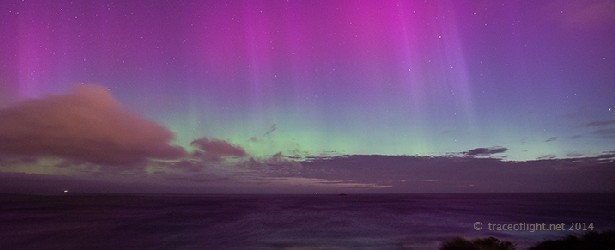
As forecasted yesterday Coronal Mass Ejection (CME) hit Earth's magnetic field around 03:00 UTC today. That's a second CME impact within 24 hours, and another round of auroras.
SWPC issued Geomagnetic K-index of 6 (G2 – Moderate) alert at 05:28 UTC. Area of impact primarily poleward of 55 degrees Geomagnetic Latitude. Power grid fluctuations can occur. High-latitude power systems may experience voltage alarms. Satellite orientation irregularities may occur; increased drag on low Earth-orbit satellites is possible. HF (high frequency) radio propagation can fade at higher latitudes. Aurora may be seen as low as New York to Wisconsin to Washington state.
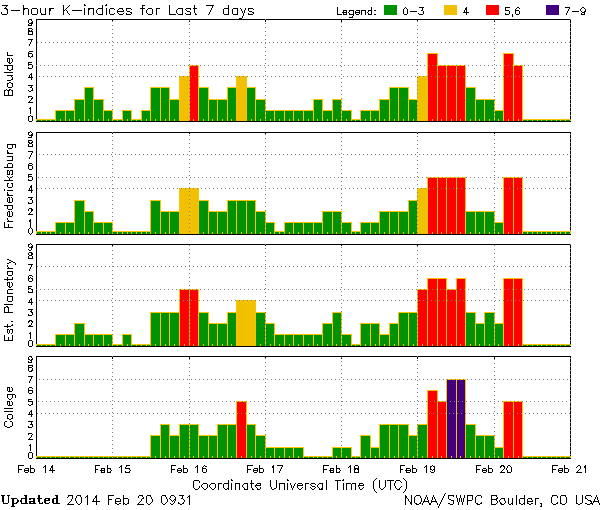
Space Weather Message Code: ALTK06
Serial Number: 318
Issue Time: 2014 Feb 20 0528 UTCALERT: Geomagnetic K-index of 6
Threshold Reached: 2014 Feb 20 0528 UTC
Synoptic Period: 0300-0600 UTC
Active Warning: Yes
NOAA Scale: G2 – Moderate
Potential Impacts: Area of impact primarily poleward of 55 degrees Geomagnetic Latitude.
Induced Currents – Power grid fluctuations can occur. High-latitude power systems may experience voltage alarms.
Spacecraft – Satellite orientation irregularities may occur; increased drag on low Earth-orbit satellites is possible.
Radio – HF (high frequency) radio propagation can fade at higher latitudes.
Aurora – Aurora may be seen as low as New York to Wisconsin to Washington state.
The following image of Aurora Australis was taken by Taichi Nakamura on February 19, 2014 @ Dunedin, New Zealand: "The glows from the auroras were strong last night. The curtains of light were weaving before completely dark and quite high in altitude. Some almost straight above us. Quite exciting as it was the biggest and strongest Southern light I saw so far this year. Shots were attempted with Canon 5D, 6D and x6i with around 3800K 8sec F3 iso 1600."
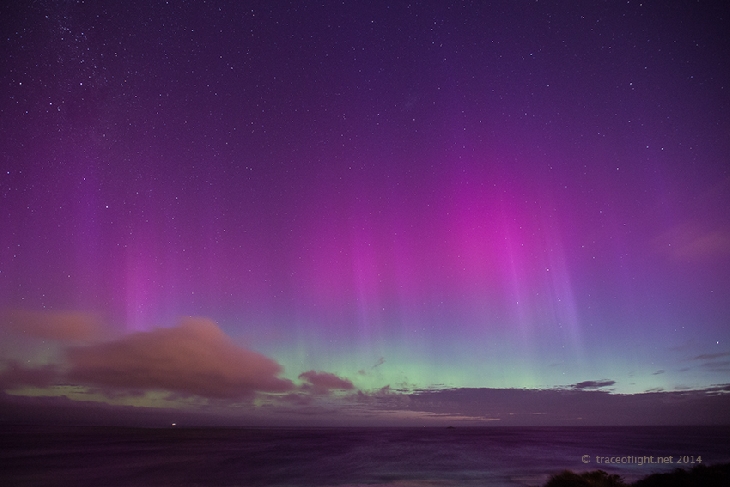
Aurora Australis – Dunedin, New Zealand – February 19, 2014. Image copyright Taichi Nakamura – TraceOfLight.net (via SpaceWeather's – RealTime Aurora Gallery)
M-class solar flare
Decaying AR 1976 located on western limb erupted with M-class solar flare peaking at 07:56 UTC as M3.0. Short duration 10cm Radio Burst measuring 280 sfu and a Type II radio emission with estimated velocity of 844 km/s were registered. Type II emissions occur in association with eruptions on the sun and typically indicate a coronal mass ejection is associated with a flare event.
This flare also produced a 10 MeV proton event that exceeded the 10 pfu threshold at 08:55 UTC. Potential Impacts from the proton event include: Minor impacts on polar HF (high frequency) radio propagation resulting in fades at lower frequencies.
Update: A fast moving CME associated with the M3 flare was first seen in Lasco C2 imagery at 08:00 UTC. An Enlil run will be submitted to determine potential speed and impacts to Earth, but initial indications point to an approximate arrival time at Earth late on February 22.
A 12-degree filament, centered near S34E02, erupted during 19/14:34 – 15:55 UTC; associated with a southward, non-Earth-directed CME. An additional filament was seen departing the northern portion of the solar disk during approximately 20/01:29 – 07:44 UTC. All indications show this CME is directed too far north to have impacts at Earth. (SWPC)
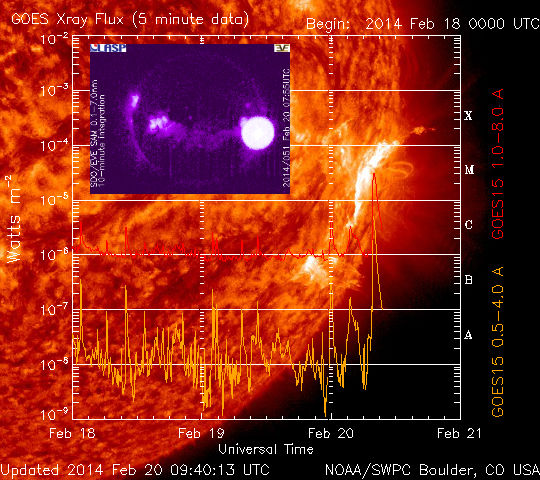
Space Weather Message Code: ALTTP2
Serial Number: 910
Issue Time: 2014 Feb 20 0755 UTCALERT: Type II Radio Emission
Begin Time: 2014 Feb 20 0745 UTC
Estimated Velocity: 844 km/s
Description: Type II emissions occur in association with eruptions on the sun and typically indicate a coronal mass ejection is associated with a flare event.
***
SUMMARY: 10cm Radio Burst
Begin Time: 2014 Feb 20 0730 UTC
Maximum Time: 2014 Feb 20 0730 UTC
End Time: 2014 Feb 20 0730 UTC
Duration: 1 minutes
Peak Flux: 280 sfu
Latest Penticton Noon Flux: 158 sfu
Description: A 10cm radio burst indicates that the electromagnetic burst associated with a solar flare at the 10cm wavelength was double or greater than the initial 10cm radio background. This can be indicative of significant radio noise in association with a solar flare. This noise is generally short-lived but can cause interference for sensitive receivers including radar, GPS, and satellite communications.
Sunspots
There are currently 6 numbered sunspot regions on the disk.
Slight spot decay was noted in Region 1976. Region 1982 showed gradual spot and penumbra development in its intermediate portion, along with a mix of magnetic polarities. Minor spot development was noted in the intermediate portion of Region 1981 (S07E33, Dai/beta). Minor spot development was noted in newly-numbered Region 1985 (N07W46, Bxo/beta). (SWPC – February 20, 2014 – 00:30 UTC)
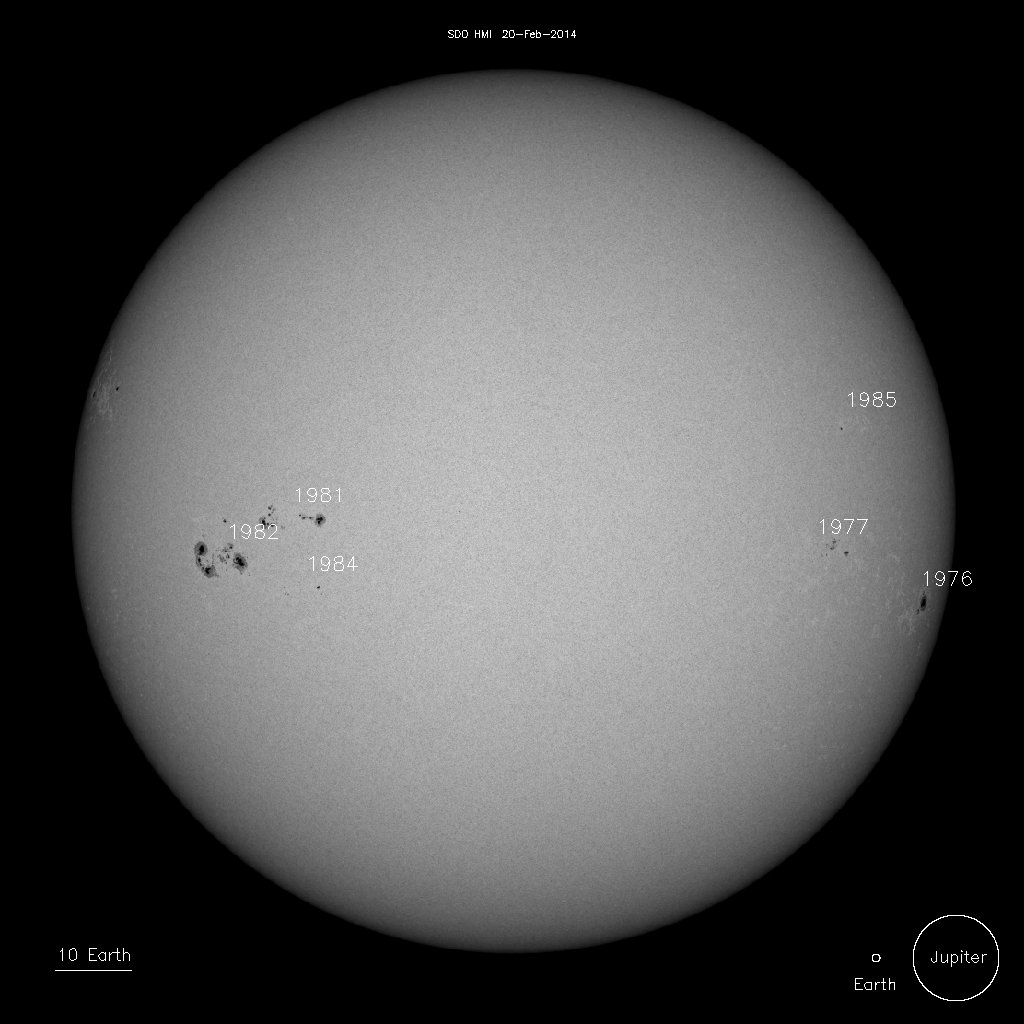
Sunspots on February 20, 2014. Image credit: SDO / HMI
1974 S12W0* 354 480 12 EKC 10 BG
1976 S14W69 320 180 4 HAX 5 A
1977 S10W41 291 90 12 CAI 18 B
1981 S07E33 217 140 8 DAI 13 B
1982 S11E44 205 500 8 DKI 20 BG
1984 S16E32 218 20 4 CRO 4 B
1985 N07W46 297 10 4 BXO 3 B
Solar wind and geospace update
From SWPC – Forecast Discussion at 12:30 UTC on February 20, 2014:
Solar wind
.24 hr Summary…
ACE data began the period with enhanced levels due to the earlier arrival of a CME, likely associated with a faint full-halo CME on February 16. Conditions then stabilized for several hours until approximately 20/03:01 UTC when a shock was observed at ACE, sending IMF Bt to 9 nT and Bz to -9 nT. Winds also increased from 461 km/s to 660 km/s with temperature and density seeing increases as well. Since the shock arrival, wind speeds have been observed as high as 734 km/s, IMF Bt has remained between 10 nT and 15 nT, and the Bz component has mostly been negative with occasional periods in the positive sector.
.Forecast…
Solar wind conditions are expected to gradually recover from this latest CME during the latter half of February 20. Another CME passage is forecast to begin late on February 20 (from the halo CME observed on Feb 18). Wind speed is expected to be above 500 km/s with this CME passage (based on the latest Enlil model output), along with increased IMF Bt and IMF Bz variability. CME effects are expected to persist during February 21, then possibly see another enhancement during February 22 from yet another CME. This one from the M3/Sn flare that occurred today. Analysis is ongoing to determine exact timing of the arrival of a couple of CMEs observed today and adjustments will be made accordingly.
Geospace
.24 hr Summary…
The geomagnetic field was at quiet to major storm levels (G2-Moderate) due to another CME passage.
.Forecast…
The geomagnetic field is expected to be at major storm levels (G2 – Moderate) for the next few hours as CME effects continue. Eventually, field activity is expected to decrease to unsettled to active levels, with a chance for minor storm (G1 – Minor) mid to late on February 20, continuing into February 21 due to an expected CME passage. Activity is expected to decrease to quiet levels late on February 21 as CME effects subside. Unsettled to active levels with a chance for minor storm (G1 – Minor) conditions are expected to persist through midday on February 22 with the possibility of yet another CME passage, this one from the M3 flare earlier today.
Featured image: Aurora Australis – Dunedin, New Zealand – February 19, 2014. Image copyright Taichi Nakamura – TraceOfLight.net (via SpaceWeather's – RealTime Aurora Gallery)

Commenting rules and guidelines
We value the thoughts and opinions of our readers and welcome healthy discussions on our website. In order to maintain a respectful and positive community, we ask that all commenters follow these rules.